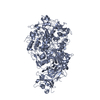+Search query
-Structure paper
| Title | Structure and mechanism of the Nap adhesion complex from the human pathogen Mycoplasma genitalium. |
|---|---|
| Journal, issue, pages | Nat Commun, Vol. 11, Issue 1, Page 2877, Year 2020 |
| Publish date | Jun 8, 2020 |
 Authors Authors | David Aparicio / Margot P Scheffer / Marina Marcos-Silva / David Vizarraga / Lasse Sprankel / Mercè Ratera / Miriam S Weber / Anja Seybert / Sergi Torres-Puig / Luis Gonzalez-Gonzalez / Julian Reitz / Enrique Querol / Jaume Piñol / Oscar Q Pich / Ignacio Fita / Achilleas S Frangakis /   |
| PubMed Abstract | Mycoplasma genitalium is a human pathogen adhering to host target epithelial cells and causing urethritis, cervicitis and pelvic inflammatory disease. Essential for infectivity is a transmembrane ...Mycoplasma genitalium is a human pathogen adhering to host target epithelial cells and causing urethritis, cervicitis and pelvic inflammatory disease. Essential for infectivity is a transmembrane adhesion complex called Nap comprising proteins P110 and P140. Here we report the crystal structure of P140 both alone and in complex with the N-terminal domain of P110. By cryo-electron microscopy (cryo-EM) and tomography (cryo-ET) we find closed and open Nap conformations, determined at 9.8 and 15 Å, respectively. Both crystal structures and the cryo-EM structure are found in a closed conformation, where the sialic acid binding site in P110 is occluded. By contrast, the cryo-ET structure shows an open conformation, where the binding site is accessible. Structural information, in combination with functional studies, suggests a mechanism for attachment and release of M. genitalium to and from the host cell receptor, in which Nap conformations alternate to sustain motility and guarantee infectivity. |
 External links External links |  Nat Commun / Nat Commun /  PubMed:32513917 / PubMed:32513917 /  PubMed Central PubMed Central |
| Methods | EM (subtomogram averaging) / EM (single particle) / X-ray diffraction |
| Resolution | 2.65 - 15.0 Å |
| Structure data |  EMDB-10259:  EMDB-10260: EMDB-10890: cryo-electron density map of the P140-P110 heterodimer  PDB-6rut:  PDB-6s3u: |
| Chemicals |  ChemComp-HOH: |
| Source |
|
 Keywords Keywords | SUGAR BINDING PROTEIN / Adhesion complex / PROTEIN BINDING / CELL ADHESION / P110/P140 Nap Mycoplasma genitalium surface adhesin |
 Movie
Movie Controller
Controller Structure viewers
Structure viewers About Yorodumi Papers
About Yorodumi Papers





 mycoplasma genitalium g37 (bacteria)
mycoplasma genitalium g37 (bacteria)